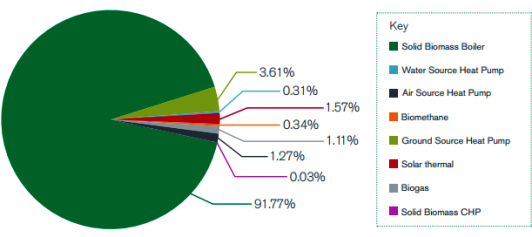After several months of consultation about removing new solar thermal systems from the Renewable Heat Incentive (RHI) starting in 2017, the British government announced on 14 December 2016 that the support will in fact continue. The government published the results of the consultation in a document called The Renewable Heat Incentive: A Reformed Scheme (see attached pdf). Here it was announced that support for new solar thermal installations will in fact continue through the RHI scheme without changes. Hence the tariff for the households will remain at the current level of 0.1974 Pound Sterling (GBP)/kWh paid over seven years and for non-households the tariff will remain at the current level of 0.1028 GBP/kWh over 20 years. Solar space heating is still not eligible. The chart shows the small portion of solar thermal accredited installations (1.57 %) in the non-domestic RHI between Q2 2014 and Q3 2016 – in total 223 solar applications since the start of the programme.
Chart: Ofgem
Strong support for solar thermal in responses
The responses received to the consultation strongly supported the continued inclusion of solar thermal in both schemes. Of the 230 responses received to withdrawing support for new solar thermal systems in the domestic RHI, 92% did not agree with the proposal.
This proportion was the same for the non-domestic part. The government acknowledged that if support were to be removed there could be a potentially significant detrimental effect on deployment and the supply chain, including UK manufacturing of solar thermal panels. Considering the whole consultation, a large portion of respondents answered only those questions relating to solar thermal.
Many respondents were in favour of retaining solar thermal on the basis that it is the lowest cost of all the RHI technologies, the easiest to deploy and use. Many of those who supported solar thermal highlighted the positive points made in the consultation about solar thermal:
- Solar thermal has an important role going forward in de-carbonising heating
- It has the lowest upfront costs for consumers
- It can also act as a valuable adjunct to heat pumps and biomass boilers.
The industry welcomes the announcement
On the website of the UK’s Solar Trade Association (STA) the Chief Executive Paul Barwell commented: “Solar thermal is back, which is great news for businesses and families who want to bring down their energy bills and do their bit to mitigate climate change. It is to the new Energy Department’s credit that they listened to the very strong arguments we made for retaining solar thermal within the RHI.” Peter Randall, Managing Director of the design and installation company Solar Kingdom based in Edinburgh, Scotland, confirmed: “The announcement is very welcome. The original premise for the removal of solar thermal from the RHI was seriously flawed. The STA and other interested bodies put forward a strong case for its continuing inclusion.” This was echoed by Kathy McVeigh, Managing Director of CoolSky based in Northern Ireland: “It would have been shameful if solar thermal had not been included in the RHI. The STA lobbied strongly for inclusion and it is fantastic to see their efforts awarded. Hopefully this will give the industry an opportunity to recover.”
RHI results for first half of 2016
During the consultation, the scheme has continued to support solar thermal. The latest figures for solar thermal shown for the first half of 2016 indicate there was an average of 2.5 installs per day for the domestic RHI and ten days between each non-domestic RHI install. The question remains, if there is no change in government support, will this continue to be the level of UK sales? McVeigh responded: “We would hope to see an increase in sales in 2017 and feel very positively that many projects that were in limbo, will now go ahead. Areas where solar thermal has a lot of potential include new build, commercial hot water for applications such as nursing homes, leisure centres, hotels and restaurants as well as industrial process heat.”
Randall added: “There will be no explosive growth, but a gradual increase as confidence returns to the market. This in turn should lead to new participants entering, which will drive competition with the ensuing benefits it brings. The benefits that flow from energy labelling of hot water systems and storage tanks has been overlooked. Few are fully acquainted with how the
package label works.”
Competition from PV sales under the Feed-in Tariff
Another common consultation response was that solar thermal deployment has been significantly affected by solar PV sales under the Feed-in Tariff scheme. It was argued that since the PV tariff was reduced earlier in 2016, there is now a more level playing field for solar thermal. This in turn could lead to cost-savings and therefore better value for money. There were also a number of responses that noted the importance of solar thermal for those less able to pay due to low upfront costs and minimal running costs. The small number of respondents who were against supporting solar thermal expressed the following main reasons:
- Not the most cost-effective way to reach targets
- Does not deliver value for money
- The market is well established so doesn’t require further funding.
Solar thermal for space heating
During the consultation process stakeholders claimed the need making solar thermal assisted space heating an eligible technology under the RHI. The government responded, however, that the evidence submitted did not sufficiently demonstrate that a further development could be incentivised by RHI support. This remains quite surprising when commercial calculation methods already exist in the industry and also in European standards like BS EN 15316. There are locations particular in rural off-gas network areas where properties already have the extra space needed for the heat storage and so can use solar-assisted space heating.
Websites of institutions and companies mentioned in the text:

